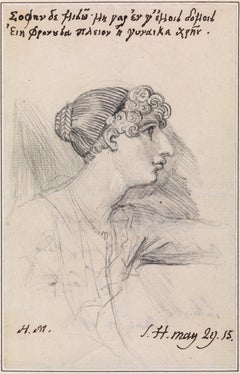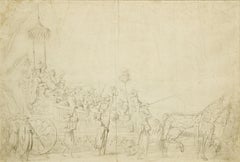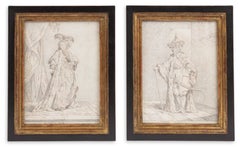Henry Fuseli Art
to
2
2
2
1
1
Overall Height
to
Overall Width
to
2
2
2
2
1
1
1
1
1
2
6,886
3,209
2,514
1,217
1
1
Artist: Henry Fuseli
Drawing of a captive woman
By Henry Fuseli
Located in London, GB
Collections:
Sir Thomas Lawrence, who acquired the contents of Fuseli’s studio;
Susan, Countess of Guilford, née Coutts (1771-1837), acquired from the Lawrence estate;
Susan, Baroness North (1797-1884), daughter of the above;
Mrs A. M. Jaffé, acquired in France, c. 1950 to 2016.
Black chalks, on buff-coloured paper
Stamped verso: ‘Baroness Norths Collection / of Drawings by H Fuseli Esq.’
Framed dimensions: 26.38 x 20.63 inches
This boldly drawn sheet depicting a seated figure was made by Fuseli at an important and highly productive moment in his career. The monumental drawing is closely related to another sheet by Fuseli in the British Museum which Schiff published as subject unknown. Both drawings were made when Fuseli was designing his most important sequence of historical works, including scenes from Shakespeare and Milton, The Nightmare and The Death of Dido which was exhibited at the Royal Academy to great critical acclaim in 1781. The present drawing does not relate directly to any of Fuseli’s finished historical paintings of the period, but evidently the image of a slightly menacing, seated and covered old woman was precisely the sort of motif he was playing with. It is notable that the same figure reappears later in Fuseli’s work as the witch from Ben Jonson’s Witch’s Song which Fuseli produced as both a painting and engraving in 1812.
Fuseli returned to London in 1779 from a highly creative and productive period in Rome and established himself as one of the leading history painters of the period. Fuseli re-established contact with his old mentor Sir Joshua Reynolds, becoming a regular guest at his dinner table and visitor to his studio. The earliest and most striking manifestation of this strategy was Fuseli's Death of Dido, exhibited in 1781 at the Royal Academy. Executed on the same scale as Reynolds's version (Royal Collection), Fuseli's vertically oriented picture was hung directly opposite Reynolds's with its horizontal orientation, inevitably inviting comparison between the two works and garnering Fuseli much publicity and favourable reviews in the newspapers.
The present, previously unpublished sheet, relates closely to a drawing now in the British Museum. That sheet shows the same seated old woman, drawn on a smaller scale and more schematic in design, seated next to an anatomical drawing of a man. The pose of this figure is related to the pose of Dido in his Death of Dido; the foreshortened torso, arrangement of head, oblique view of Dido’s features and arms all suggest that the study can be viewed as an initial thought for the composition. Fuseli may have initially thought of including the figure of the hunched and covered old woman. Drawn on identical paper to the British Museum sheet, our study is an enlarged depiction of the same figure, more elaborately delineated and developed. The presence of a chain to the right of the figure, suggests that the iconography was related in some way to a scene of imprisonment.
Fuseli had first explored the motif of the hooded old woman in an early Roman drawing, 'The Venus Seller'. The idea of a grotesque old woman, hooded and with angular nose and projecting chin seen in profile was most spectacularly used by Fuseli in his sequence of paintings depicting The Three Witches from Macbeth. Fuseli seems to have kept the present sheet and may have returned to it when preparing a painting of The Witch and the Mandrake from Ben Jonson’s Witch’s Song from his Masque of Queens in 1812. Here the same seated figure looks out from under her hood and picks a mandrake by moonlight. Jonson’s drama had been performed at the court of James I in 1609, inspired the subject. To throw the nobility of the queens into relief, the poet added a coven of witches, one of whom declares: ‘I last night lay all alone, On the ground, to hear the mandrake groan; And plucked him up, though he grew full low, And, as I had done, the cock did crow.’ The figure was reversed in the associated etching which was published in 1812. It seems likely that the present drawing remained as part of Fuseli’s working archive of figure studies.
The present drawing was presumably purchased with the bulk of Fuseli’s drawings after the artist’s death by Sir Thomas Lawrence. Lawrence’s large group of Fuseli drawings were then acquired by Susan, Countess of Guildford (1771-1837). Lady Guildford was the eldest daughter of the banker Thomas Coutts (1735-1822), who himself had supported Fuseli’s journey to Rome in the 1770s and had remained one of the artist’s key...
Category
18th Century Old Masters Henry Fuseli Art
Materials
Chalk
Portrait drawing of Harriot Mellon, Mrs Thomas Coutts
By Henry Fuseli
Located in London, GB
Inscribed by the artist in pen and brown ink, upper margin: 'σοφὴν δὲ μισῶ: μὴ γὰρ ἔν γ' ἐμοῖς δόμοις / εἴη φρονοῦσα πλείον' ἢ γυναῖκα χρή [Euripides, Hippolytus, 11, 640-41: “But a ...
Category
19th Century Old Masters Henry Fuseli Art
Materials
Pencil
Related Items
Study for « The Chinese Masquerade » by Jean-Baptiste Pierre (1714 - 1789)
By Jean-Baptiste Pierre
Located in PARIS, FR
Arriving in Rome in June 1735 as a resident at the Royal Academy, Pierre was unable to attend the Winter Carnival festivities of 1735, which he nevertheless immortalised in an engrav...
Category
1730s Old Masters Henry Fuseli Art
Materials
Graphite
Costume drawings for ‘Ambassadeur de Siam’ and ‘La Sultana Reine’
Located in Amsterdam, NL
Joseph-Marie Vien (1716-1809)
‘Ambassadeur de Siam’ and ‘La Sultana Reine’
Both titled lower centre, the drawing of the ambassador inscribed with colours intended for the prints, e...
Category
Mid-18th Century Old Masters Henry Fuseli Art
Materials
Paper, Pencil
Free Shipping
H 9.26 in W 6.89 in D 1.19 in
Memento mori - A study of a Skull
Located in Stoke, Hampshire
E. Rusch (late 19th century)
Memento mori - Study of a skull
Pencil drawing
Drawing Size - 11 x 18 in
Framed Size - 17 1/2 x 24 1/2 in
Memento mori is an artistic or symbolic trope acting as a reminder of the inevitability of death. The concept has its roots in the philosophers of classical antiquity and Christianity, and appeared in funerary art and architecture from the medieval period...
Category
19th Century Old Masters Henry Fuseli Art
Materials
Pencil
Antique French Miniature Portrait of Lady Biographical details with painting
Located in Cirencester, Gloucestershire
Miniature Portrait
French School, late 18th/ early 19th century
framed: 5.5 x 5.5 inches
board: 2 x 2 inches
provenance: private collection, France
condition: very good and sound c...
Category
Late 18th Century Old Masters Henry Fuseli Art
Materials
Watercolor
Boissier, Portrait of a Young Man, 1802, Pastel signed and dated
By Boissier
Located in Paris, FR
Boissier (painter and portraitist active at the end of the 18th century)
Portrait of a young man
Signed and dated "Boissier f(ecit) 1802" on the lower right
Pastel on paper transfere...
Category
Early 1800s Old Masters Henry Fuseli Art
Materials
Pastel
Study after Michelangelo’s “The Last Judgment”
By Michelangelo Buonarroti
Located in New York, NY
Italian School, 16th Century
Provenance:
Private Collection, New York
This intriguing drawing is a study by an anonymous 16th-century Italian artist after a vignette in Michelangelo’s fresco of The Last Judgement in the Sistine Chapel. The altar wall of the Sistine Chapel was already richly decorated when Pope Clement VII commissioned Michelangelo to paint his Last Judgment...
Category
16th Century Old Masters Henry Fuseli Art
Materials
Paper, Gouache
Italian 18th Century red chalk study of a seated man by Zuccarelli
Located in Petworth, West Sussex
Francesco Zuccarelli RA (Italian, 1702-1788)
Study of a seated man
Red chalk
11.1/8 x 7.5/8 in. (28.3 x 19.3 cm.)
Provenance; Colnaghi & Co, London
Francesco Zuccarelli was born in ...
Category
18th Century Old Masters Henry Fuseli Art
Materials
Chalk
H 11.13 in W 7.63 in D 1 in
Jean-Henri Cless (1774-1812) Portrait of a young woman, signed drawing
Located in Paris, FR
Jean-Henri Cless (1774-1812)
Portrait of a young woman in a landscape
signed "Cless fec" for fecit on the lower left
Brown ink and brown ink wash on pencil
Size of the sheet : 31.5 x 22 cm
Size of the motive : 24.5 x 17 cm
very simply framed under glass without actual frame 32 x 22.5 cm
This pre...
Category
Early 1800s Old Masters Henry Fuseli Art
Materials
Ink, Pencil
Moses Breaking the Tablet of the Law (after Parmigianino. 1503-1540)
By Daniel Ramée
Located in Storrs, CT
Moses Breaking the Tablet of the Law. (after Parmigianino. 1503-1540.) Pencil drawing mounted onto paper. 12 1/4 x 3 3/4 inches. Collector's seal verso: Gustav Grunwald, (Lugt 1155b)...
Category
19th Century Old Masters Henry Fuseli Art
Materials
Pencil
H 20 in W 11.5 in D 1 in
The Martyrdom of the Santi Quattro Coronati
Located in New York, NY
Provenance:
Private Collection, UK
After initial training under Justus Suttermans and Vincenzo Dandini, in 1673 Anton Domenico Gabbiani embar...
Category
17th Century Old Masters Henry Fuseli Art
Materials
Paper, Chalk, Ink, Pen
The Flight into Egypt
Located in New York, NY
Inscribed: 3. una Madonna che va in Egitto, verso, and Madonna che va in Egitto, recto
Provenance:
Private Collection, UK, since 1999
This expressive and boldly executed drawing is the work of Luca...
Category
16th Century Old Masters Henry Fuseli Art
Materials
Chalk, Ink, Pen, Paper
Fine 18th Century Italian Old Master Drawing Mother & Children
Located in Cirencester, Gloucestershire
Giovanni Battista Cipriani, RA,
Italian 1727-1785
Sketch of a mother with three children;
black and red chalk on laid paper with watermark '© TAYLOR', 22.4 x 17.5 cm.
Provenanc...
Category
18th Century Old Masters Henry Fuseli Art
Materials
Chalk
Henry Fuseli art for sale on 1stDibs.
Find a wide variety of authentic Henry Fuseli art available for sale on 1stDibs. You can also browse by medium to find art by Henry Fuseli in chalk, pencil and more. Much of the original work by this artist or collective was created during the 18th century and is mostly associated with the Old Masters style. Not every interior allows for large Henry Fuseli art, so small editions measuring 5 inches across are available. Customers who are interested in this artist might also find the work of George Romney, Jan Pieter Verdussen, and Michela De Vito. Henry Fuseli art prices can differ depending upon medium, time period and other attributes. On 1stDibs, the price for these items starts at $27,254 and tops out at $29,731, while the average work can sell for $28,492.
Artists Similar to Henry Fuseli
Carle Vernet (Antoine Charles Horace Vernet)
Questions About Henry Fuseli Art
- 1stDibs ExpertApril 22, 2024Henry Fuseli's famous painting is called The Nightmare. The Swiss painter completed the work in 1871. It depicts an incubus sitting atop the prone body of a sleeping woman. You can see it on display at the Detroit Institute of Arts in Detroit, Michigan. On 1stDibs, shop a selection of Henry Fuseli art.



